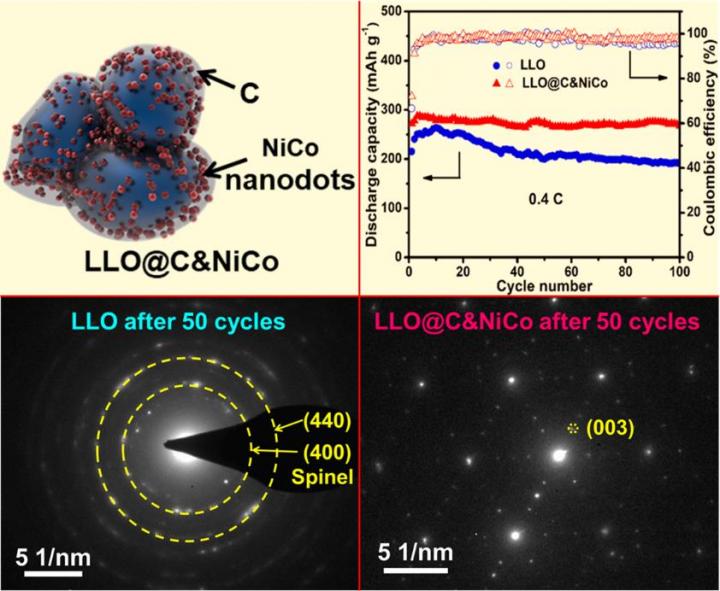Novel MOF shell-derived surface modification of Li-rich layered oxide cathode

This is a schematic illustration of LLO@C&NiCo; Cycling performance and the corresponding Coulombic efficiencies tested at current densities of 0.4 C; SAED patterns of LLO and LLO@C&NiCo after 50 cycles at 0.4 C. Credit: ©Science China Press
Compared with the commercial graphite (theoretical-capacity 372 mAh g-1), the LiCoO2 has a low specific capacity of 150 mAh g-1 which becomes a big bottleneck of the battery breakthroughs. Among numerous cathode materials, Li-rich layered oxide (LLO) materials have attracted increasing attention as promising candidates because of their high specific capacity (> 250 mAh g-1) and high operating voltage (> 3.5 V vs. Li+/Li). However, an undesired spinel growth in the layered host structure usually occurred from the surface during the long-term cycling, which led to the fast capacity fading and voltage decaying.
Prof. L. Q. Mai has led a research team at Wuhan University of Technology aiming to improve the electrochemical performance of electrode materials. They have developed a facile and general carbon coating technology [1].
The unique NiCo nanodots decorated carbon shell was constructed on the as-prepared Li1.2Mn0.54Ni0.13Co0.13O2 nanoparticles masterly on this basis [2]. The obtained LLO@C&NiCo cathode exhibits enhanced cycling and rate capability with a capacity retention of 95% after 100 cycles at 0.4 C, 90% after 300 cycles at 2 C and a high capacity of 159 mAh g-1 at 5 C, respectively.
The in-situ X-ray diffraction, electrochemical impedance spectroscopy and selected area electron diffraction analyses after cycling demonstrate that the LLO@C&NiCo as a cathode material for LIBs exhibiting superior electrochemical performances, which is due to its unique protective C&NiCo shell. It promotes the electron conductivity (5 times), reduces the diffusion impedance, provides a robust structure for LLO which suppresses the undesired formation of the spinel phase initiated from the particle surface during cycling, and also protects the surface structure from side reactions at the electrode/electrolyte interface.
###
This research was supported by the National Key Research and Development Program of China (2016YFA0202603) and the National Basic Research Program of China (2013CB934103).
See the articles:
Jiashen Meng, Xiong Liu, Jiantao Li, Qi Li, Chuan Zhao, Linhan Xu, Xuanpeng Wang, Fang Liu, Wei Yang, Xiaoming Xu, Ziang Liu, Chaojiang Niu, and Liqiang Mai. General oriented synthesis of precise carbon-confined nanostructures by low-pressure vapor superassembly and controlled pyrolysis. Nano letters, DOI: 10.1021/acs.nanolett.7b03982 https:/
Zhitong Xiao, Jiashen Meng, Qi Li, Xuanpeng Wang, Meng Huang, Ziang Liu, Chunhua Han, and Liqiang Mai. Novel MOF shell-derived surface modification of Li-rich layered oxide cathode for enhanced lithium storage. Science Bulletin, 2017, Doi : 10.1016/j.scib.2017.12.011
Media Contact
All latest news from the category: Materials Sciences
Materials management deals with the research, development, manufacturing and processing of raw and industrial materials. Key aspects here are biological and medical issues, which play an increasingly important role in this field.
innovations-report offers in-depth articles related to the development and application of materials and the structure and properties of new materials.
Newest articles

Superradiant atoms could push the boundaries of how precisely time can be measured
Superradiant atoms can help us measure time more precisely than ever. In a new study, researchers from the University of Copenhagen present a new method for measuring the time interval,…

Ion thermoelectric conversion devices for near room temperature
The electrode sheet of the thermoelectric device consists of ionic hydrogel, which is sandwiched between the electrodes to form, and the Prussian blue on the electrode undergoes a redox reaction…

Zap Energy achieves 37-million-degree temperatures in a compact device
New publication reports record electron temperatures for a small-scale, sheared-flow-stabilized Z-pinch fusion device. In the nine decades since humans first produced fusion reactions, only a few fusion technologies have demonstrated…





















